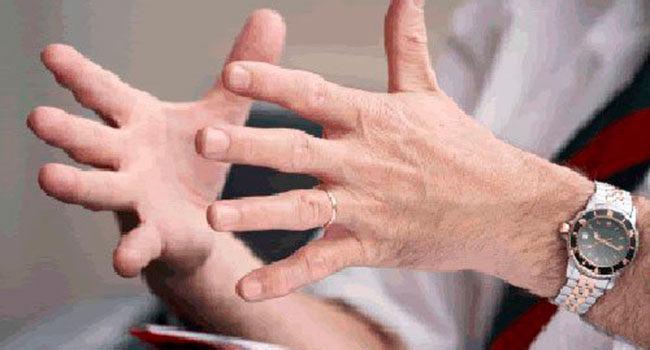 Have you ever noticed that when people are passionate about what they’re saying, their gestures automatically become more animated? Their hands and arms move about, emphasizing points and conveying enthusiasm.
Have you ever noticed that when people are passionate about what they’re saying, their gestures automatically become more animated? Their hands and arms move about, emphasizing points and conveying enthusiasm.
You may not have been aware of this connection before, but you instinctively felt it. Research shows that audiences tend to view people who use a greater variety of gestures in a more favorable light. Studies have found that people who communicate through active gesturing tend to be evaluated as warm, agreeable, and energetic, while those who remain still (or whose gestures seem mechanical or “wooden”) are seen as logical, cold, and analytic.
That’s one of the reasons why gestures are so critical to a leader and why getting them right in a presentation connects so powerfully with an audience.
I’ve seen senior executives make rookie mistakes. When leaders don’t use gestures correctly (if they let their hands hang limply to the side, hide them in pockets or clasp their hands in front of their bodies in the classic “fig leaf” position), it suggests they don’t recognize the crucial issues, they have no emotional investment in the issues, or they don’t realize the impact of their nonverbal behaviour on the audience.
We all form impressions about a speaker that help determine how we interpret what the speaker is saying – and the impression we get about someone’s trustworthiness is a critically important factor in effective communication. If an audience does not trust the presenter, or at least think that the speaker believes what he is saying, then it will be almost impossible for that speaker to get his message across.
Trust is established through congruence – that perfect alignment between what is being said and the body language that accompanies it. If a speaker’s gestures are not in full agreement with the spoken words, the audience consciously or subconsciously perceives duplicity, uncertainty or (at the very least) internal conflict.
Although people may not be aware they are doing so, audience members are also evaluating a leader’s sincerity by the timing of his or her gestures: Authentic gestures begin split seconds before the words that accompany them. They will either precede the word or will be coincident with the word, but will never come after the word.
To use gestures effectively, leaders need to be aware of how those movements will most likely be perceived. Here are some common hand gestures and the messages behind them:
Emblematic gestures – Some gestures have an agreed-upon meaning to a group and are consciously used instead of words. These are referred to as emblematic gestures, and, like the words they represent, they’re processed in the left hemisphere of the brain. We learn emblematic gestures at home, in school, and in other social environments, so they generally differ from culture to culture. So remember that what may be effective communication in one culture can become ineffective or even offensive in another.
Emblematic gestures used in the U.S. and Canada include the thumbs-up sign that is commonly understood to mean “good job,” “OK” or “everything’s fine,” and hand rocking – where the palm faces down and the fingers spread out and the hand rocks left and right – means “so-so” or “maybe.”
Pacifying gestures – When nervous or stressed, people pacify themselves with a variety of self-touching gestures. They rub their legs, pull at their collars, and cross their arms to hold their upper arms in a kind of “self-hug.” In a presentation, any pacifying gesture (including hand wringing, rubbing the forehead, playing with jewelry or hair, etc.) makes a leader look tentative, unprepared or insecure.
Illustrative gestures – Everyone produces gestures spontaneously and unwittingly as they speak. We may seldom think of our gestures consciously, but in practice we use them with great efficiency and sophistication to cover a surprisingly wide range of communicating.
Sometimes gestures are used to physically illustrate a point, as when pointing to a particular paragraph in a contract or moving your hand to the right when telling someone to turn in that direction. Other gestures are unconscious signals that give the viewer a glimpse into the speaker’s emotions, motivations or attitude. These include . . .
Open palms at an angle – Gestures with palms showing (tilted to a 45 degree angle) signal candor and openness. When being truthful or forthcoming, people tend to use open gestures, showing their palms and wrists and spreading hands and arms away from their bodies, as if saying, “See, I have nothing to hide.”
Palms up – When palms are rotated straight up and fingers are spread, in a prototypical pleading position, it communicates the lack of something that the speaker needs or is requesting.
Palms down – Speakers pronate their palms (the palm faces down or back) to signal power and certainty. This is also a controlling signal – as when trying to quiet an audience.
Vertical palms – Vertical palm gestures with a rigid hand are often used to demonstrate the need for precise measurement – or to beat out a rhythm that gives emphasis to certain words.
Clenched hands – When a speaker clutches an object tightly, grips his hands behind his back, or curls his hands into fists, it signals anger, frustration or a nonverbal way of saying, “I’m holding on to something and I’m not going to open up to you.” Depending on the context, the clenched fist gesture can also communicate a warning that unwavering fortitude may be necessary to achieve an objective. I’ve often seen leaders use a fist to add the nonverbal equivalent of “with power”, “firm commitment,” or “by force” to their message.
Finger pointing – Finger pointing and wagging are parental gestures of scolding, and I’ve often seen politicians and executives, in particular, use this gesture in meetings, negotiations, or interviews for emphasis or to show dominance. The problem is that, rather than being a sign of authority, aggressive finger pointing suggests that the leader is losing control of the situation – and the gesture smacks of playground bullying.
Hands on hips – Whether in a stubborn toddler or an aggressive CEO, hands on hips is one of the most common gestures used to communicate a defiant, super-confident, or independent attitude.
Hidden hands – Hidden hands make you look less trustworthy. This is one of the nonverbal signals that is deeply ingrained in our subconscious. Our ancestors made survival decisions based solely on bits of visual information they picked up from one another. In our prehistory, when someone approached with hands out of view, it was a clear signal of potential danger. Although today the threat of hidden hands is more symbolic than real, our psychological discomfort remains.
Steepling gestures – It is common to see a speaker using a steepling gesture (palms separated slightly, fingers of both hands spread and finger tips touching) when feeling confident or comfortable about a subject she knows well. Politicians, executives, professors, and attorneys are very fond of using these gestures when they speak.
Hand gestures of enthusiasm – There is an interesting equation of hand and arm movement with energy. If a leader wanted to project more enthusiasm and drive, she could do so by increased gesturing. On the other hand, over-gesturing (especially when hands are raised above the shoulders) can make her appear erratic, less believable and less powerful.
Hand gestures of composure – Arms held at waist height, and gestures within that horizontal plane, help you – and the audience – feel centered and composed. Arms at waist and bent to a 45 degree angle (accompanied by a stance about shoulder-width wide) is also the posture I advise leaders to assume between gestures. It helps keep them grounded, energized, and focused.
Troy Media columnist Carol Kinsey Goman, PhD, is an executive coach, consultant, and international keynote speaker at corporate, government, and association events. She is also the author of STAND OUT: How to Build Your Leadership Presence.
The views, opinions and positions expressed by columnists and contributors are the author’s alone. They do not inherently or expressly reflect the views, opinions and/or positions of our publication.

